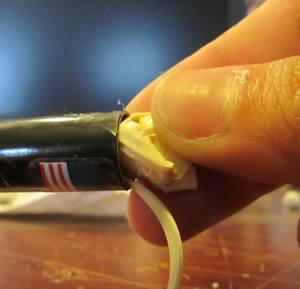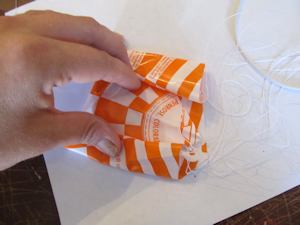This post will be long, so I'm breaking it into two parts. I don't want you to think it's really complicated, or that launching a rocket takes a long time - it doesn't. But there are some details you need to get right to have a successful, safe, awesome rocket launch, and I don't want to leave anything out.
Rocket Flight
Here's basically what'll happen. You'll load up the rocket, put it on the launch pad, hook up the launch controller, press the launch button, and it should take off into the sky. The motor (or engine) will burn for a second or two (this phase is known as powered flight), and when it stops burning, the rocket will continue to coast upward. You'll see white smoke coming from the back of the rocket for several seconds as it does; this is the delay charge burning. The delay produces no thrust, but it allows the rocket to coast up to its apogee - the uppermost part of its flight. Then, the motor will fire the ejection charge - a tiny explosion that will push the nose cone off and eject the parachute. The parachute should open, and the rocket will drift back to earth.
What are you going to need?
Here are the basics:
- A rocket
- A launch pad - with a launch rod
- A launch controller
- Some rocket motors - or, as Estes and many people call them, engines
- Some igniters - these usually come with motors or engines, so you shouldn't need to buy any
- Some recovery wadding
- Something to carry all this stuff
Well, as I've recommended in the previous post, you might want to get launch kit. You can get a basic Estes kit - or Quest - which will have the launch pad and rod, the launch controller, and a rocket for less than you'd pay for the pad and controller plus no rocket at all, if you'd bought them separately.
 |
| An Estes launch pad - with a round metal blast deflector and a 33-inch launch rod. The cap at the top of the rod comes off - it's to prevent you gouging your eyes out when prepping the rocket! |
A launch pad comes with a metal disk called a "blast deflector," and it's not optional! This will deflect the hot gasses and burning propellant away from the ground, and protect the plastic from melting.
The launch rod is usually about 3 feet long. The purpose of the rod has to do with rocket stability. The only thing keeping the rocket going upward instead of straight at the crowd is the fins. And for the fins to work, the rocket has to be moving upward, so there's wind moving past them. The launch rod keeps the rocket moving straight up until it is going fast enough - at least 30 miles per hour - for the fins to do their job. With model rockets, it takes only a fraction of a second to reach that velocity or much higher, so a 3-foot rod is usually plenty.
The Estes rods are 33 inches - close enough - and come in two parts which you have to push together. There's a narrow, curved bit of metal shoulder material in one half of the rod which you push into a hollow onto the other half. I found I had to crimp mine with pliers to get the halves together.
Tap one end of the rod on a concrete surface to get the pieces completely together - but don't try to hammer them. The rod will bend, and if that happens, you need a new rod!
Estes recommends using sand paper to smooth out the joint between the rods. Don't do this. What happened when I did this was that I scuffed the chrome coating off the rod, making it rougher! You could try some steel wool, but honestly, unless the joint is way off, you'll be fine.
The rod gets inserted into a little hole in the top of the launch pad. There's a little safety cap included which you place on top of the rod when you're not actually launching a rocket - this is to prevent you bending over the rod and gouging your eyes out. I've mentioned that rocketry has a great safety record - I read once that the most dangerous thing about launching rockets is that rod!
 |
| Arr! Don't be the guy who loses an eye launching rockets! |
The launch controller is a plastic box with a button, a light, and a removable "key" - usually a bit of wire or metal with a plastic button on top of it - and a couple of wires coming out one end with little clips on the ends of them. The controller takes batteries, and it ignites the motors electrically. The key is a safety feature. Once you hook the rocket up, you cannot launch it accidentally by hitting the launch button with your thumb, because you have to put the key in the launch controller and press it down before it will work.
The light is known as a continuity light, and when you hook up the rocket igniters to the launch controller, and put in the key, this will light up. It tells you that electricity is flowing through the system, the batteries are good, and the igniters are not broken.
 |
| Typical Estes launch controller, from Chris Michielssen's modelrocketbuilding.blogspot.com. If you haven't seen his blog, you need to check it out! |
The launch button... uh, launches the rocket.
***I do have to say something important here, in case you are not going strictly the Estes route for your first rocket launch. Currently, Quest motors and igniters are out of stock, but once Quest motors are back out again, this is very important: You cannot use an Estes launch controller with Quest igniters. Quest makes a very sensitive igniter. They require very little current to flow through them to actually cause them to fire - which is a good thing, for certain applications. But an Estes launch controller doesn't have enough resistance in it, and as soon as you put the safety key into the Estes launch controller, instead of just the continuity light coming on, a Quest igniter will get enough juice to fire prematurely. If there's someone at the launch pad making an adjustment, that can be dangerous!***
A rocket motor is a heavy paper cylinder which encases a solid propellant - in this case, black powder. One end has a little hole in it - the nozzle - and the other end has a clay cap in it.
 |
| A typical 3-pack of black powder motors - in this case, Estes B6-4. That's an average thrust of 6 Newtons and a delay of 4 seconds. |
 |
| The nozzle end - this sticks out the back of the rocket. |
 |
| The clay cap end - goes into the rocket pointed toward the nose cone. In A and B motors, this is further recessed into the motor, because there's less propellant inside. |
 |
| The motor on the left has no clay cap - you can see the black powder propellant. This is only for multistage rockets. Put that one away for now. We'll do staging later! |
Your first rocket will come with a list of recommended motors to use. Read these. First time I launched the Big Bertha, it was kind of windy, and I didn't want to lose my beautiful new rocket. So, I put an A motor in it.
Problem is, the Bertha is kind of heavy. An A8-3 motor doesn't have enough power to properly lift it. It flew about 30-50 feet into the air, took a nose dive, and straight down for 3 seconds (that was the delay time!). The nose cone ejected about 5 feet from the ground, and the rocket drove itself into the damp earth.
 | |
| The fancy, homemade launch controller makes me look like an "expert," but the crash landing goes to show that I'm still kind of a n00b. |
There will be a list of appropriate motors with your rocket. There's usually one with an asterisk (often the least powerful one) that says "first flight." This is so that, if, say, it's windy, you're less likely to lose the rocket when the parachute drifts too far, or if you made some kind of catastrophic error in the construction of your rocket, the damage will be minimal.
The igniter is a little wire thing that comes with the motors. It's usually made of high-resistance nichrome wire. The resistance is important, because when electricity flows through a high-resistance wire, the wire heats up. This happens in an incandescent light bulb, and in the wires of a toaster - which are also made of nichrome. Most Estes igniters are also tipped with a combustible material called pyrogen.
 |
| To igniters - you snip these apart before using them. |
 |
| Motor packs include tiny plastic plugs for securing igniters into the nozzle of the motor. |
You insert the motor into the back of the rocket with the nozzle end - the little hole - pointing out the back of the rocket. Secure the motor with the motor hook (or sometimes you tape it in, if the kit instructions tell you to do that). The motor hook should lock into place once the motor is all the way in. Tug on the motor gently to make sure that when it moves backward, the hook holds it in firmly by the edge.
Now, pull out the nose cone, parachute and shock cord. You need to protect the parachute from the burning particles of the ejection charge, or it will melt together and won't open. Into the rocket body, you put recovery wadding. Tear off individual sheets, and roll them loosely into little wadded balls of paper - not too tight! The instructions on your kit will tell you how many pieces you'll need for your particular rocket. Put them one by one into the body of the rocket, and if you need to, push them down very gently with a dowel rod.
 |
| Picture from stormthecastle.com |
Next, you need to fold the parachute and insert it and the shock cord into the rocket. There are lots of ways to fold parachutes, but some ways are better than others. Doing it by the instructions in the Estes kits is terrible - mine do not deploy at least 50% of the time when I do it this way. We're going to do it another way.
 |
| The Estes "fold over and roll both ends to the center" technique - terrible. The shroud lines get tangled, and the chutes often fail to deploy. |
Plastic parachutes sometimes have problems deploying. This can be due to static electricity, or cold, or bad folding. In any case, you'll help the parachute properly deploy if you give it a few dashes of talcum powder or baby powder.
I prep my rockets before going to the flying field by laying the parachute open on a table.
 |
| The Big Bertha 18-inch parachute ready for prep |
 |
| Sprinkle a little baby powder or talcum on the chute to aid deployment |
Next, fold the chute in half, with two of the corners being at the top of the fold. Now you'll have half a hexagon, with four corners showing - two at the top and two at the bottom.
Take one of the top corners and fold it down to the bottom corner on the opposite side. Then do the same for the other top corner. You now have a triangle, with all the shroud lines - the strings on the parachute - coming off the two corners at the bottom.
 |
| Fold one of the top corners down to the opposite bottom corner - in this case, top right to bottom left. |
 |
| Then do the same for the opposite top corner - here, top left to bottom right. You now have a triangle with shroud lines coming from the bottom two corners. |
Take most of the extra slack that leads from the parachute to the nose cone and gently lay it on top of the parachute.
 |
| Gently lay the slack from the shroud lines on top of the folded parachute. |
Fold that outside corner over the shroud lines, then fold the top corner down about a third of the way, then fold what you have down again.
 |
| Fold that outside corner over the shroud lines |
 |
| Fold the top third of the parachute down. |
 |
| Fold that down over the bottom third. |
Next, roll the whole thing up into a little packet and gently wrap whatever is left of the shroud lines around the parachute into a helical shape, making sure you don't cross over what you've already rolled.
 |
| Roll the folded chute down into a sausage shape |
 |
| Wrap the shroud lines in one bundle around the chute, moving from one end to another, in a helix. Don't cross lines back over what you've already rolled! |
 |
| The shock cord in a larger rocket like the Big Bertha goes in quite easily - put that in first. |
Put the nose cone on top, and make sure it's snug, but not tight. You should be able to easily pull it out with your hand, but it shouldn't be so loose it falls out if you turn the rocket over and give a little shake. If it's too loose, add a little strip of masking tape to the shoulder. If it's too tight, sand the shoulder down a little bit.
 |
| The nose cone of my Cosmic Explorer is just a little too loose. A few bits of masking tape makes it snug enough to fly. |
You then insert the igniter into the nozzle of the motor, making sure it touches the propellant inside. It doesn't have to go very far, and you don't need to force it. Just set the tip of the igniter gently into the nozzle until it stops.
 |
| Don't insert the igniter until it's in the rocket and at the launch pad!I'm just doing it on the table here for the purpose of taking pictures. |
Next, you'll secure the igniter into the nozzle with either a little plastic plug that comes with the motor (in the case of Estes motors), or with a piece of masking tape. Either way, this will bend the igniter's leads into a 90 degree angle. Make sure the two wires leading into the nozzle don't touch each other - this creates a short circuit, which means that when you press the launch button, nothing will happen.
Now, you'll bend the ends of the igniter wires away from each other. You can bend them into little rabbit-ear loops, or simply bend them away from each other at a wide angle. The rabbit ears are easier to connect to the clips, but as long as the two wire leads aren't near each other, you'll be fine.
The rocket is now prepped for flight.
In Part 2, we'll launch the sucker!
[Click here for Part 2]










No comments:
Post a Comment